Financial Decisions: Capital Structure, Governance & Project Appraisal
VerifiedAdded on 2023/06/10
|13
|3840
|493
Report
AI Summary
This report provides a comprehensive financial analysis, evaluating a company's capital structure comprising equity shares and bonds, emphasizing control, risk, and cost considerations. It critically examines the principles of corporate governance, including accountability, responsibility, transparency, and fairness, alongside the need for a stakeholder approach in corporate strategies. The report includes a detailed calculation of the Net Present Value (NPV) for two projects, recommending the selection of Project B based on its higher NPV, and calculates the Internal Rate of Return (IRR) for Project A, evaluating the strengths and weaknesses of the IRR method. Furthermore, it discusses methods for incorporating risk into the investment appraisal process and explores methods for managing capacity utilization, including calculating the optimal product mix and sales mix plan. This document is available on Desklib, a platform offering a wide range of study resources and AI-powered tools for students.

exam
Paraphrase This Document
Need a fresh take? Get an instant paraphrase of this document with our AI Paraphraser
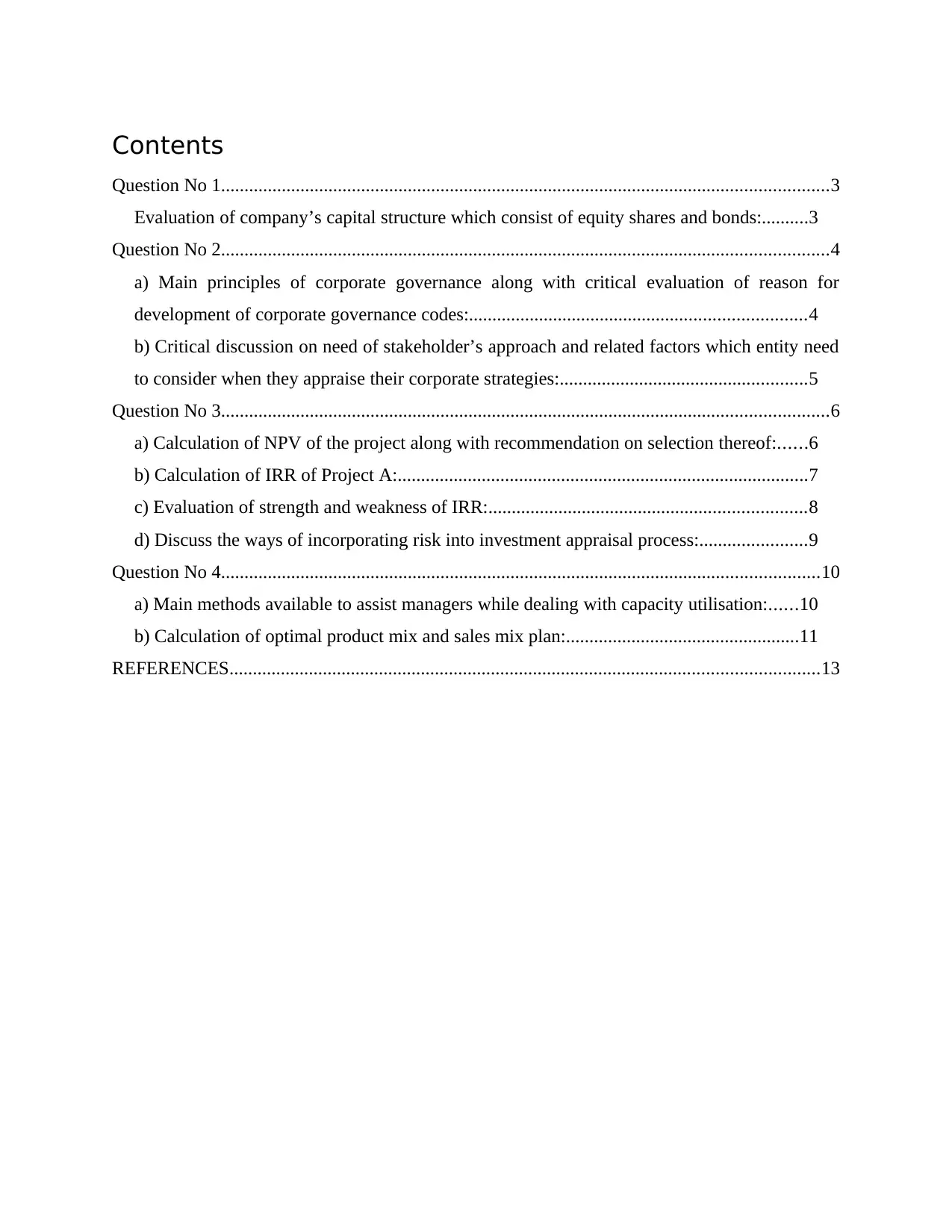
Contents
Question No 1..................................................................................................................................3
Evaluation of company’s capital structure which consist of equity shares and bonds:..........3
Question No 2..................................................................................................................................4
a) Main principles of corporate governance along with critical evaluation of reason for
development of corporate governance codes:........................................................................4
b) Critical discussion on need of stakeholder’s approach and related factors which entity need
to consider when they appraise their corporate strategies:.....................................................5
Question No 3..................................................................................................................................6
a) Calculation of NPV of the project along with recommendation on selection thereof:......6
b) Calculation of IRR of Project A:........................................................................................7
c) Evaluation of strength and weakness of IRR:....................................................................8
d) Discuss the ways of incorporating risk into investment appraisal process:.......................9
Question No 4................................................................................................................................10
a) Main methods available to assist managers while dealing with capacity utilisation:......10
b) Calculation of optimal product mix and sales mix plan:..................................................11
REFERENCES..............................................................................................................................13
Question No 1..................................................................................................................................3
Evaluation of company’s capital structure which consist of equity shares and bonds:..........3
Question No 2..................................................................................................................................4
a) Main principles of corporate governance along with critical evaluation of reason for
development of corporate governance codes:........................................................................4
b) Critical discussion on need of stakeholder’s approach and related factors which entity need
to consider when they appraise their corporate strategies:.....................................................5
Question No 3..................................................................................................................................6
a) Calculation of NPV of the project along with recommendation on selection thereof:......6
b) Calculation of IRR of Project A:........................................................................................7
c) Evaluation of strength and weakness of IRR:....................................................................8
d) Discuss the ways of incorporating risk into investment appraisal process:.......................9
Question No 4................................................................................................................................10
a) Main methods available to assist managers while dealing with capacity utilisation:......10
b) Calculation of optimal product mix and sales mix plan:..................................................11
REFERENCES..............................................................................................................................13
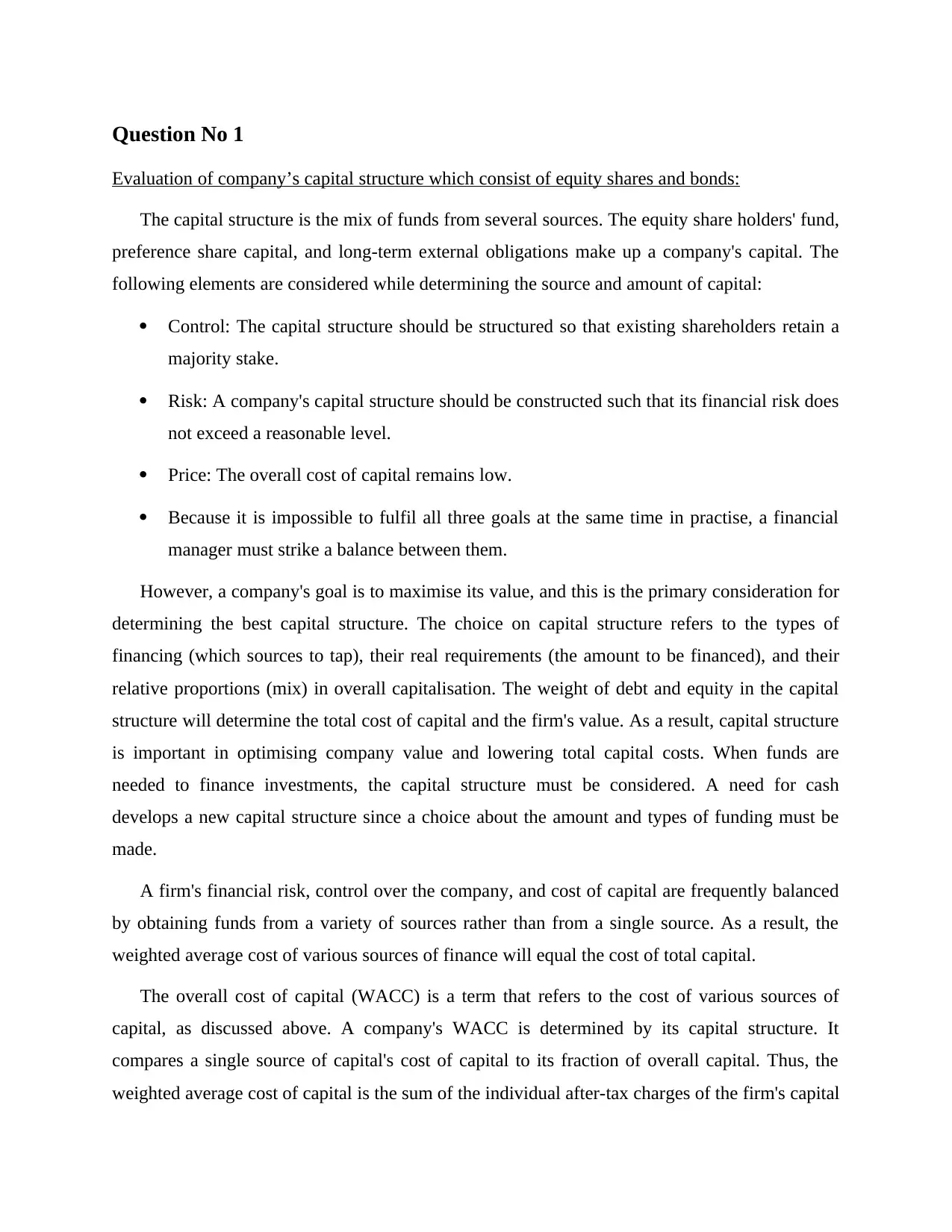
Question No 1
Evaluation of company’s capital structure which consist of equity shares and bonds:
The capital structure is the mix of funds from several sources. The equity share holders' fund,
preference share capital, and long-term external obligations make up a company's capital. The
following elements are considered while determining the source and amount of capital:
Control: The capital structure should be structured so that existing shareholders retain a
majority stake.
Risk: A company's capital structure should be constructed such that its financial risk does
not exceed a reasonable level.
Price: The overall cost of capital remains low.
Because it is impossible to fulfil all three goals at the same time in practise, a financial
manager must strike a balance between them.
However, a company's goal is to maximise its value, and this is the primary consideration for
determining the best capital structure. The choice on capital structure refers to the types of
financing (which sources to tap), their real requirements (the amount to be financed), and their
relative proportions (mix) in overall capitalisation. The weight of debt and equity in the capital
structure will determine the total cost of capital and the firm's value. As a result, capital structure
is important in optimising company value and lowering total capital costs. When funds are
needed to finance investments, the capital structure must be considered. A need for cash
develops a new capital structure since a choice about the amount and types of funding must be
made.
A firm's financial risk, control over the company, and cost of capital are frequently balanced
by obtaining funds from a variety of sources rather than from a single source. As a result, the
weighted average cost of various sources of finance will equal the cost of total capital.
The overall cost of capital (WACC) is a term that refers to the cost of various sources of
capital, as discussed above. A company's WACC is determined by its capital structure. It
compares a single source of capital's cost of capital to its fraction of overall capital. Thus, the
weighted average cost of capital is the sum of the individual after-tax charges of the firm's capital
Evaluation of company’s capital structure which consist of equity shares and bonds:
The capital structure is the mix of funds from several sources. The equity share holders' fund,
preference share capital, and long-term external obligations make up a company's capital. The
following elements are considered while determining the source and amount of capital:
Control: The capital structure should be structured so that existing shareholders retain a
majority stake.
Risk: A company's capital structure should be constructed such that its financial risk does
not exceed a reasonable level.
Price: The overall cost of capital remains low.
Because it is impossible to fulfil all three goals at the same time in practise, a financial
manager must strike a balance between them.
However, a company's goal is to maximise its value, and this is the primary consideration for
determining the best capital structure. The choice on capital structure refers to the types of
financing (which sources to tap), their real requirements (the amount to be financed), and their
relative proportions (mix) in overall capitalisation. The weight of debt and equity in the capital
structure will determine the total cost of capital and the firm's value. As a result, capital structure
is important in optimising company value and lowering total capital costs. When funds are
needed to finance investments, the capital structure must be considered. A need for cash
develops a new capital structure since a choice about the amount and types of funding must be
made.
A firm's financial risk, control over the company, and cost of capital are frequently balanced
by obtaining funds from a variety of sources rather than from a single source. As a result, the
weighted average cost of various sources of finance will equal the cost of total capital.
The overall cost of capital (WACC) is a term that refers to the cost of various sources of
capital, as discussed above. A company's WACC is determined by its capital structure. It
compares a single source of capital's cost of capital to its fraction of overall capital. Thus, the
weighted average cost of capital is the sum of the individual after-tax charges of the firm's capital
⊘ This is a preview!⊘
Do you want full access?
Subscribe today to unlock all pages.

Trusted by 1+ million students worldwide
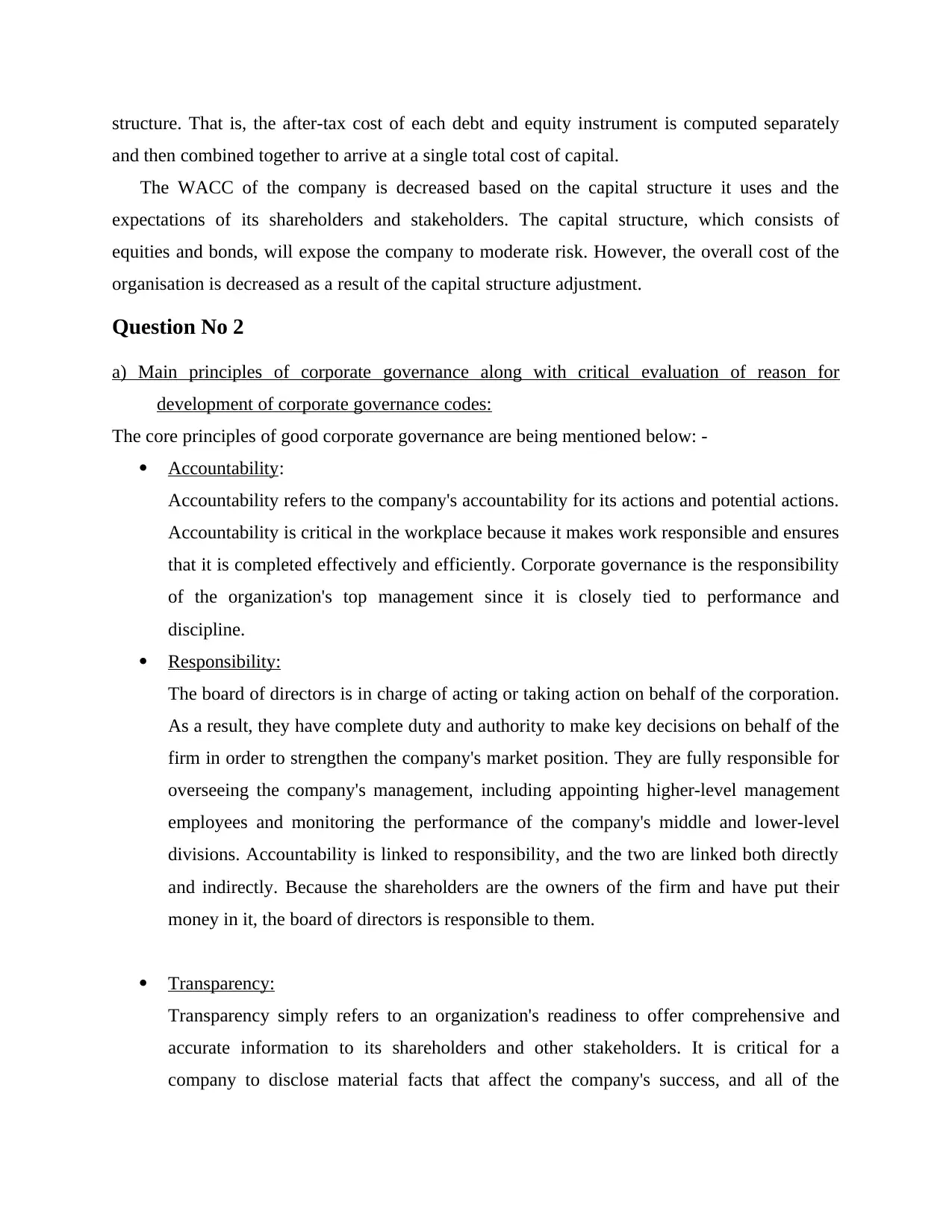
structure. That is, the after-tax cost of each debt and equity instrument is computed separately
and then combined together to arrive at a single total cost of capital.
The WACC of the company is decreased based on the capital structure it uses and the
expectations of its shareholders and stakeholders. The capital structure, which consists of
equities and bonds, will expose the company to moderate risk. However, the overall cost of the
organisation is decreased as a result of the capital structure adjustment.
Question No 2
a) Main principles of corporate governance along with critical evaluation of reason for
development of corporate governance codes:
The core principles of good corporate governance are being mentioned below: -
Accountability:
Accountability refers to the company's accountability for its actions and potential actions.
Accountability is critical in the workplace because it makes work responsible and ensures
that it is completed effectively and efficiently. Corporate governance is the responsibility
of the organization's top management since it is closely tied to performance and
discipline.
Responsibility:
The board of directors is in charge of acting or taking action on behalf of the corporation.
As a result, they have complete duty and authority to make key decisions on behalf of the
firm in order to strengthen the company's market position. They are fully responsible for
overseeing the company's management, including appointing higher-level management
employees and monitoring the performance of the company's middle and lower-level
divisions. Accountability is linked to responsibility, and the two are linked both directly
and indirectly. Because the shareholders are the owners of the firm and have put their
money in it, the board of directors is responsible to them.
Transparency:
Transparency simply refers to an organization's readiness to offer comprehensive and
accurate information to its shareholders and other stakeholders. It is critical for a
company to disclose material facts that affect the company's success, and all of the
and then combined together to arrive at a single total cost of capital.
The WACC of the company is decreased based on the capital structure it uses and the
expectations of its shareholders and stakeholders. The capital structure, which consists of
equities and bonds, will expose the company to moderate risk. However, the overall cost of the
organisation is decreased as a result of the capital structure adjustment.
Question No 2
a) Main principles of corporate governance along with critical evaluation of reason for
development of corporate governance codes:
The core principles of good corporate governance are being mentioned below: -
Accountability:
Accountability refers to the company's accountability for its actions and potential actions.
Accountability is critical in the workplace because it makes work responsible and ensures
that it is completed effectively and efficiently. Corporate governance is the responsibility
of the organization's top management since it is closely tied to performance and
discipline.
Responsibility:
The board of directors is in charge of acting or taking action on behalf of the corporation.
As a result, they have complete duty and authority to make key decisions on behalf of the
firm in order to strengthen the company's market position. They are fully responsible for
overseeing the company's management, including appointing higher-level management
employees and monitoring the performance of the company's middle and lower-level
divisions. Accountability is linked to responsibility, and the two are linked both directly
and indirectly. Because the shareholders are the owners of the firm and have put their
money in it, the board of directors is responsible to them.
Transparency:
Transparency simply refers to an organization's readiness to offer comprehensive and
accurate information to its shareholders and other stakeholders. It is critical for a
company to disclose material facts that affect the company's success, and all of the
Paraphrase This Document
Need a fresh take? Get an instant paraphrase of this document with our AI Paraphraser

company's actions must be performed on time. Transparency offers stakeholders trust in
the company's management's varied decision-making and procedures.
Fairness:
It basically implies that all shareholders and other stakeholders of the organisation should
get equal pay, regardless of their interest in the company. The stockholders have been
adequately protected by several laws that apply to the corporation, such as the Companies
Act. Not just stakeholders, but all workers, communities, and public authorities inside the
organisation must be treated equally so that work does not suffer as a result of inequity
within the business..
b) Critical discussion on need of stakeholder’s approach and related factors which entity need to
consider when they appraise their corporate strategies:
The stakeholder approach refers to a practice where the managers of the business formulates and
implements different strategies to satisfy and provide with the needs of the stakeholders to make
them stay connected with the business and its operations. The managers of the business make use
of the different market environment and the imperfections that are present in the market and
create a valuable opportunity for the business and its operations. This is an ethical concept which
is taken up by the administration of the business. It is used to address the outcome which will be
due to the decisions taken by the business, its trends in the sales and the profits which will be
earned by the management. The collective impact of the different factors on the stakeholders is
described in this approach. This theory and approach has a different principle which derives the
use of this approach in the business.
These principles of stakeholder approach are discussed below:
Principle of Entry and Exit: An entity should have unambiguous rules for hiring,
dismissing, and employee job profiles.
Externalities Principle - An entity's choices may have an impact on persons who have no
relationship with the entity. According to the principle, those who may be impacted by a
company's conclusions should be treated equally to other stakeholders.
Agency Principle - The shareholders appoint the company's management to operate its
operations. Management is not the company's owner, but rather an agent operating on its
behalf.
the company's management's varied decision-making and procedures.
Fairness:
It basically implies that all shareholders and other stakeholders of the organisation should
get equal pay, regardless of their interest in the company. The stockholders have been
adequately protected by several laws that apply to the corporation, such as the Companies
Act. Not just stakeholders, but all workers, communities, and public authorities inside the
organisation must be treated equally so that work does not suffer as a result of inequity
within the business..
b) Critical discussion on need of stakeholder’s approach and related factors which entity need to
consider when they appraise their corporate strategies:
The stakeholder approach refers to a practice where the managers of the business formulates and
implements different strategies to satisfy and provide with the needs of the stakeholders to make
them stay connected with the business and its operations. The managers of the business make use
of the different market environment and the imperfections that are present in the market and
create a valuable opportunity for the business and its operations. This is an ethical concept which
is taken up by the administration of the business. It is used to address the outcome which will be
due to the decisions taken by the business, its trends in the sales and the profits which will be
earned by the management. The collective impact of the different factors on the stakeholders is
described in this approach. This theory and approach has a different principle which derives the
use of this approach in the business.
These principles of stakeholder approach are discussed below:
Principle of Entry and Exit: An entity should have unambiguous rules for hiring,
dismissing, and employee job profiles.
Externalities Principle - An entity's choices may have an impact on persons who have no
relationship with the entity. According to the principle, those who may be impacted by a
company's conclusions should be treated equally to other stakeholders.
Agency Principle - The shareholders appoint the company's management to operate its
operations. Management is not the company's owner, but rather an agent operating on its
behalf.
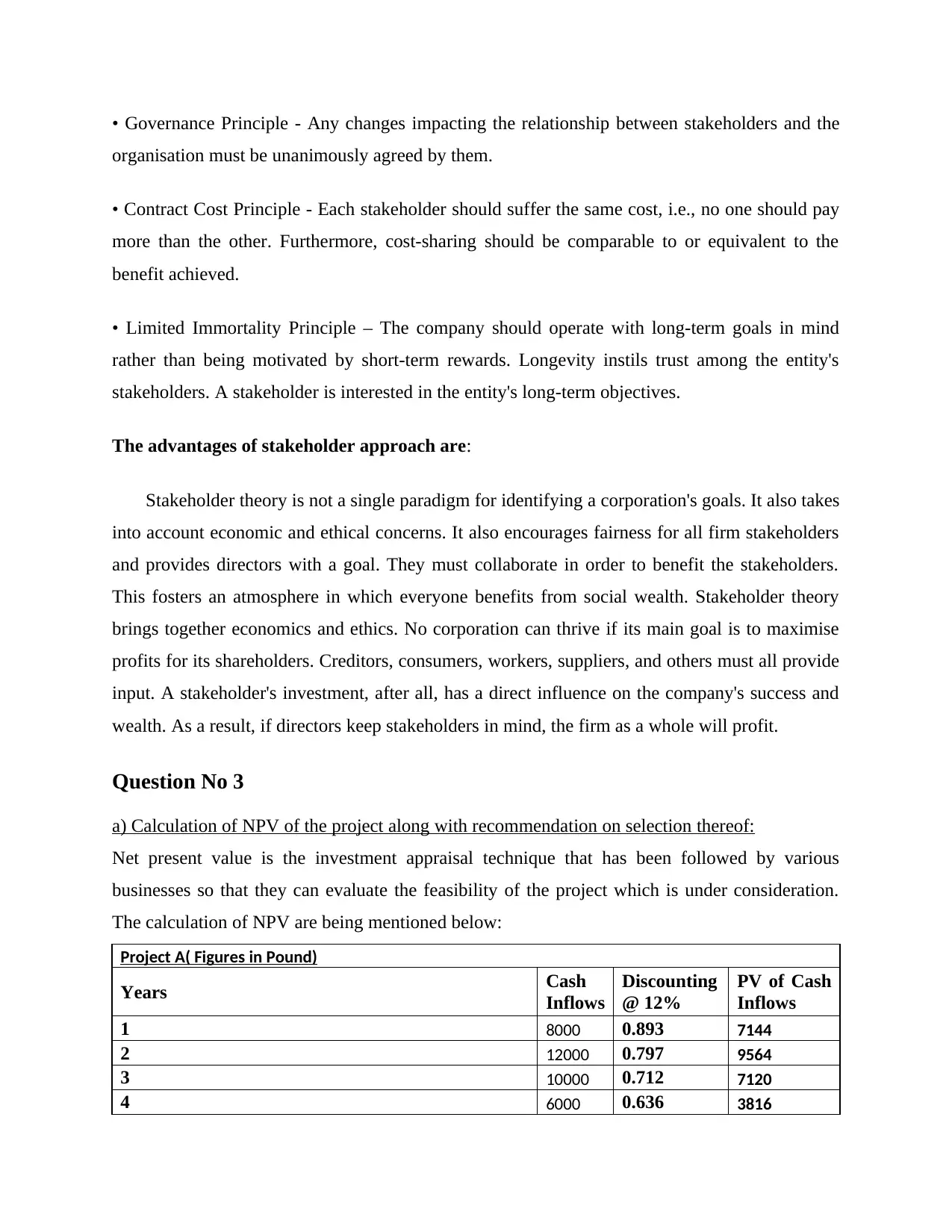
• Governance Principle - Any changes impacting the relationship between stakeholders and the
organisation must be unanimously agreed by them.
• Contract Cost Principle - Each stakeholder should suffer the same cost, i.e., no one should pay
more than the other. Furthermore, cost-sharing should be comparable to or equivalent to the
benefit achieved.
• Limited Immortality Principle – The company should operate with long-term goals in mind
rather than being motivated by short-term rewards. Longevity instils trust among the entity's
stakeholders. A stakeholder is interested in the entity's long-term objectives.
The advantages of stakeholder approach are:
Stakeholder theory is not a single paradigm for identifying a corporation's goals. It also takes
into account economic and ethical concerns. It also encourages fairness for all firm stakeholders
and provides directors with a goal. They must collaborate in order to benefit the stakeholders.
This fosters an atmosphere in which everyone benefits from social wealth. Stakeholder theory
brings together economics and ethics. No corporation can thrive if its main goal is to maximise
profits for its shareholders. Creditors, consumers, workers, suppliers, and others must all provide
input. A stakeholder's investment, after all, has a direct influence on the company's success and
wealth. As a result, if directors keep stakeholders in mind, the firm as a whole will profit.
Question No 3
a) Calculation of NPV of the project along with recommendation on selection thereof:
Net present value is the investment appraisal technique that has been followed by various
businesses so that they can evaluate the feasibility of the project which is under consideration.
The calculation of NPV are being mentioned below:
Project A( Figures in Pound)
Years Cash
Inflows
Discounting
@ 12%
PV of Cash
Inflows
1 8000 0.893 7144
2 12000 0.797 9564
3 10000 0.712 7120
4 6000 0.636 3816
organisation must be unanimously agreed by them.
• Contract Cost Principle - Each stakeholder should suffer the same cost, i.e., no one should pay
more than the other. Furthermore, cost-sharing should be comparable to or equivalent to the
benefit achieved.
• Limited Immortality Principle – The company should operate with long-term goals in mind
rather than being motivated by short-term rewards. Longevity instils trust among the entity's
stakeholders. A stakeholder is interested in the entity's long-term objectives.
The advantages of stakeholder approach are:
Stakeholder theory is not a single paradigm for identifying a corporation's goals. It also takes
into account economic and ethical concerns. It also encourages fairness for all firm stakeholders
and provides directors with a goal. They must collaborate in order to benefit the stakeholders.
This fosters an atmosphere in which everyone benefits from social wealth. Stakeholder theory
brings together economics and ethics. No corporation can thrive if its main goal is to maximise
profits for its shareholders. Creditors, consumers, workers, suppliers, and others must all provide
input. A stakeholder's investment, after all, has a direct influence on the company's success and
wealth. As a result, if directors keep stakeholders in mind, the firm as a whole will profit.
Question No 3
a) Calculation of NPV of the project along with recommendation on selection thereof:
Net present value is the investment appraisal technique that has been followed by various
businesses so that they can evaluate the feasibility of the project which is under consideration.
The calculation of NPV are being mentioned below:
Project A( Figures in Pound)
Years Cash
Inflows
Discounting
@ 12%
PV of Cash
Inflows
1 8000 0.893 7144
2 12000 0.797 9564
3 10000 0.712 7120
4 6000 0.636 3816
⊘ This is a preview!⊘
Do you want full access?
Subscribe today to unlock all pages.

Trusted by 1+ million students worldwide

4 5000 0.636 3180
Present
Value of
Cash Inflow 30824
Less: Cash
Outflow 29000
NPV 1824
Project B ( Figures in Pound)
Particular Year 1 Year 2 Year 3
Profits 15000 20000 6000
Add: Depreciation 4000 4000 4000
Free Cash Flows 19000 24000 10000
Working Capital Recovery Nil Nil 20000
Salvage Value Nil Nil 5000
Cash Inflows 19000 24000 35000
PVF@12% 0.893 0.797 0.712
Present Value 16967 19128 24920
Total Present Value 61015
Less Cash Outflow 44000
NPV 17015
From the above it has been concluded that Project B must be selected by the organisation as it
gives higher NPV. Therefore, it is recommended to the entity is to make investment in the
Project B.
b) Calculation of IRR of Project A:
IRR is the rate at which present value of cash inflows is equals to present value of cash outflows.
To calculate the IRR trial and error method has been used.
Starting rate for discounting is 12% for which the NPV is calculated below:
Project A( Figures in Pound)
Years Cash
Inflows Discounting @ 12%
PV of
Cash
Inflows
1 8000 0.893 7144
2 12000 0.797 9564
3 10000 0.712 7120
4 6000 0.636 3816
Present
Value of
Cash Inflow 30824
Less: Cash
Outflow 29000
NPV 1824
Project B ( Figures in Pound)
Particular Year 1 Year 2 Year 3
Profits 15000 20000 6000
Add: Depreciation 4000 4000 4000
Free Cash Flows 19000 24000 10000
Working Capital Recovery Nil Nil 20000
Salvage Value Nil Nil 5000
Cash Inflows 19000 24000 35000
PVF@12% 0.893 0.797 0.712
Present Value 16967 19128 24920
Total Present Value 61015
Less Cash Outflow 44000
NPV 17015
From the above it has been concluded that Project B must be selected by the organisation as it
gives higher NPV. Therefore, it is recommended to the entity is to make investment in the
Project B.
b) Calculation of IRR of Project A:
IRR is the rate at which present value of cash inflows is equals to present value of cash outflows.
To calculate the IRR trial and error method has been used.
Starting rate for discounting is 12% for which the NPV is calculated below:
Project A( Figures in Pound)
Years Cash
Inflows Discounting @ 12%
PV of
Cash
Inflows
1 8000 0.893 7144
2 12000 0.797 9564
3 10000 0.712 7120
4 6000 0.636 3816
Paraphrase This Document
Need a fresh take? Get an instant paraphrase of this document with our AI Paraphraser
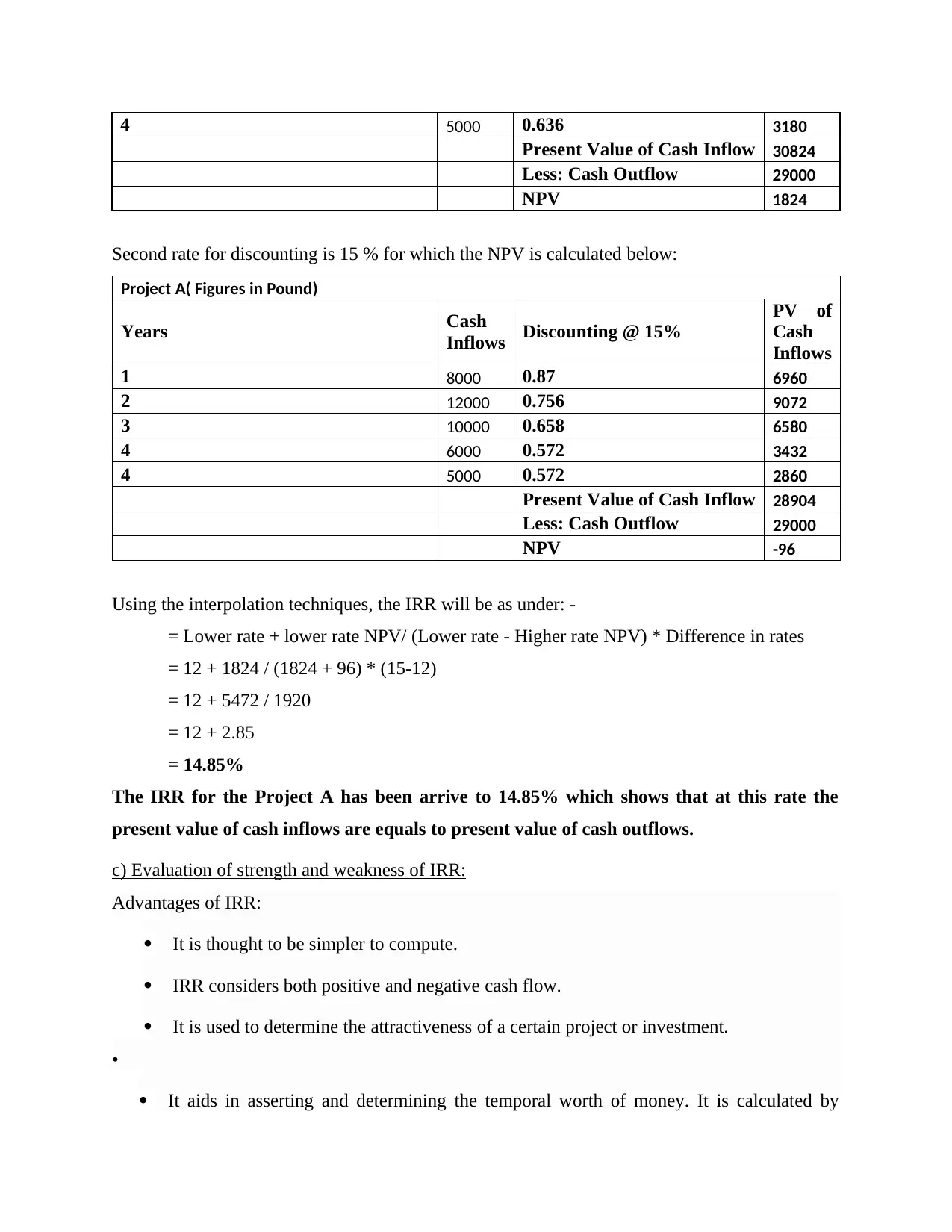
4 5000 0.636 3180
Present Value of Cash Inflow 30824
Less: Cash Outflow 29000
NPV 1824
Second rate for discounting is 15 % for which the NPV is calculated below:
Project A( Figures in Pound)
Years Cash
Inflows Discounting @ 15%
PV of
Cash
Inflows
1 8000 0.87 6960
2 12000 0.756 9072
3 10000 0.658 6580
4 6000 0.572 3432
4 5000 0.572 2860
Present Value of Cash Inflow 28904
Less: Cash Outflow 29000
NPV -96
Using the interpolation techniques, the IRR will be as under: -
= Lower rate + lower rate NPV/ (Lower rate - Higher rate NPV) * Difference in rates
= 12 + 1824 / (1824 + 96) * (15-12)
= 12 + 5472 / 1920
= 12 + 2.85
= 14.85%
The IRR for the Project A has been arrive to 14.85% which shows that at this rate the
present value of cash inflows are equals to present value of cash outflows.
c) Evaluation of strength and weakness of IRR:
Advantages of IRR:
It is thought to be simpler to compute.
IRR considers both positive and negative cash flow.
It is used to determine the attractiveness of a certain project or investment.
•
It aids in asserting and determining the temporal worth of money. It is calculated by
Present Value of Cash Inflow 30824
Less: Cash Outflow 29000
NPV 1824
Second rate for discounting is 15 % for which the NPV is calculated below:
Project A( Figures in Pound)
Years Cash
Inflows Discounting @ 15%
PV of
Cash
Inflows
1 8000 0.87 6960
2 12000 0.756 9072
3 10000 0.658 6580
4 6000 0.572 3432
4 5000 0.572 2860
Present Value of Cash Inflow 28904
Less: Cash Outflow 29000
NPV -96
Using the interpolation techniques, the IRR will be as under: -
= Lower rate + lower rate NPV/ (Lower rate - Higher rate NPV) * Difference in rates
= 12 + 1824 / (1824 + 96) * (15-12)
= 12 + 5472 / 1920
= 12 + 2.85
= 14.85%
The IRR for the Project A has been arrive to 14.85% which shows that at this rate the
present value of cash inflows are equals to present value of cash outflows.
c) Evaluation of strength and weakness of IRR:
Advantages of IRR:
It is thought to be simpler to compute.
IRR considers both positive and negative cash flow.
It is used to determine the attractiveness of a certain project or investment.
•
It aids in asserting and determining the temporal worth of money. It is calculated by
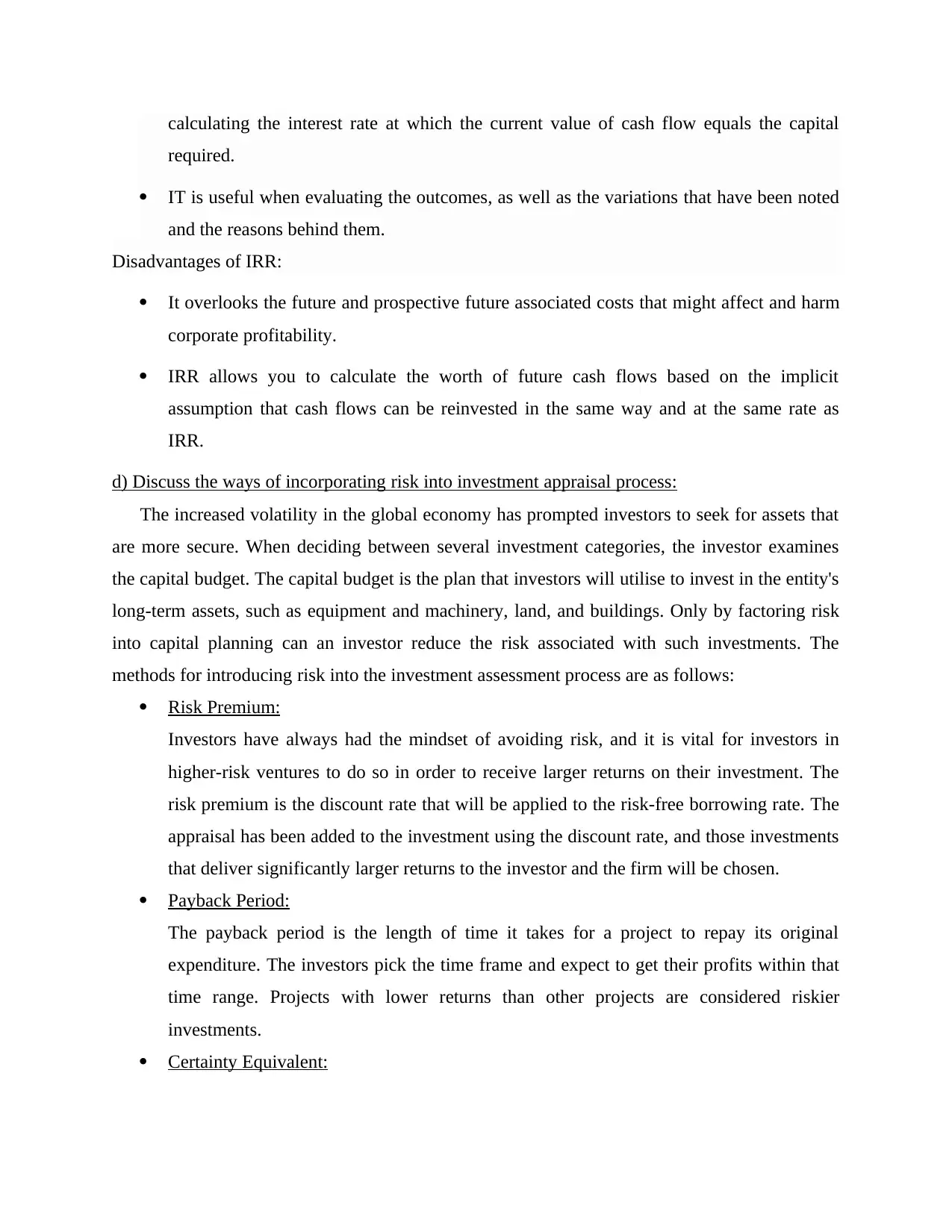
calculating the interest rate at which the current value of cash flow equals the capital
required.
IT is useful when evaluating the outcomes, as well as the variations that have been noted
and the reasons behind them.
Disadvantages of IRR:
It overlooks the future and prospective future associated costs that might affect and harm
corporate profitability.
IRR allows you to calculate the worth of future cash flows based on the implicit
assumption that cash flows can be reinvested in the same way and at the same rate as
IRR.
d) Discuss the ways of incorporating risk into investment appraisal process:
The increased volatility in the global economy has prompted investors to seek for assets that
are more secure. When deciding between several investment categories, the investor examines
the capital budget. The capital budget is the plan that investors will utilise to invest in the entity's
long-term assets, such as equipment and machinery, land, and buildings. Only by factoring risk
into capital planning can an investor reduce the risk associated with such investments. The
methods for introducing risk into the investment assessment process are as follows:
Risk Premium:
Investors have always had the mindset of avoiding risk, and it is vital for investors in
higher-risk ventures to do so in order to receive larger returns on their investment. The
risk premium is the discount rate that will be applied to the risk-free borrowing rate. The
appraisal has been added to the investment using the discount rate, and those investments
that deliver significantly larger returns to the investor and the firm will be chosen.
Payback Period:
The payback period is the length of time it takes for a project to repay its original
expenditure. The investors pick the time frame and expect to get their profits within that
time range. Projects with lower returns than other projects are considered riskier
investments.
Certainty Equivalent:
required.
IT is useful when evaluating the outcomes, as well as the variations that have been noted
and the reasons behind them.
Disadvantages of IRR:
It overlooks the future and prospective future associated costs that might affect and harm
corporate profitability.
IRR allows you to calculate the worth of future cash flows based on the implicit
assumption that cash flows can be reinvested in the same way and at the same rate as
IRR.
d) Discuss the ways of incorporating risk into investment appraisal process:
The increased volatility in the global economy has prompted investors to seek for assets that
are more secure. When deciding between several investment categories, the investor examines
the capital budget. The capital budget is the plan that investors will utilise to invest in the entity's
long-term assets, such as equipment and machinery, land, and buildings. Only by factoring risk
into capital planning can an investor reduce the risk associated with such investments. The
methods for introducing risk into the investment assessment process are as follows:
Risk Premium:
Investors have always had the mindset of avoiding risk, and it is vital for investors in
higher-risk ventures to do so in order to receive larger returns on their investment. The
risk premium is the discount rate that will be applied to the risk-free borrowing rate. The
appraisal has been added to the investment using the discount rate, and those investments
that deliver significantly larger returns to the investor and the firm will be chosen.
Payback Period:
The payback period is the length of time it takes for a project to repay its original
expenditure. The investors pick the time frame and expect to get their profits within that
time range. Projects with lower returns than other projects are considered riskier
investments.
Certainty Equivalent:
⊘ This is a preview!⊘
Do you want full access?
Subscribe today to unlock all pages.

Trusted by 1+ million students worldwide

The cash flows that will be received in the future are calculated using probability
measures such as forecasting techniques at the time of project appraisal, but these
pictures do not offer a precise picture of future occurrences. It is important to multiply the
cash flows with CE factors in order to transform them into specific cash flows. Risky
investments are avoided because they have a low certainty equivalent rating in the
market. This is due to the low likelihood of netting the expected cash flows.
Sensitivity Analysis:
Sales, investments, tax rate, and cost of sales all impact the return on investment of a
project. The amount to which the project's cash flows shift in reaction to changes in one
of these parameters is measured through sensitivity analysis. Identifying the elements
that impact the project's cash flows, developing a mathematical link between these
factors, and examining how a change in each of these factors affects the project's cash
flows are all part of the sensitivity analysis process. If any of the above-mentioned
issues affect a project's cash flow, it is deemed dangerous and should be avoided.
Question No 4
a) Main methods available to assist managers while dealing with capacity utilisation:
The following are the approaches by which the manager of the entity deals with capacity
utilisation:
Boost Planned Manufacturing: It's never easy to get the funds you imagine you'll need to
launch a firm. Raising funds from the market is a time-consuming procedure that requires
careful planning. Planning ahead of time allows you to make the greatest use of your
resources. Many would-be entrepreneurs are having difficulty adapting to rapid changes
in production, demand, manufacturing, and so on. When done from the ground up, it
always results in efficiency at every level. The two pillars of good operations, including
capacity utilisation, are planning and scheduling.
Sharing Capacity: Sharing capacity is becoming a popular technique to make the most of
available resources. It is a win-win situation for all sides since they profit equally. It
improves their chances of remaining in the market with little funds. An owner can
provide required industrial capacity, benefiting both the owner and the searchers. This
enhances utilisation and minimises investment duplication while also increasing
measures such as forecasting techniques at the time of project appraisal, but these
pictures do not offer a precise picture of future occurrences. It is important to multiply the
cash flows with CE factors in order to transform them into specific cash flows. Risky
investments are avoided because they have a low certainty equivalent rating in the
market. This is due to the low likelihood of netting the expected cash flows.
Sensitivity Analysis:
Sales, investments, tax rate, and cost of sales all impact the return on investment of a
project. The amount to which the project's cash flows shift in reaction to changes in one
of these parameters is measured through sensitivity analysis. Identifying the elements
that impact the project's cash flows, developing a mathematical link between these
factors, and examining how a change in each of these factors affects the project's cash
flows are all part of the sensitivity analysis process. If any of the above-mentioned
issues affect a project's cash flow, it is deemed dangerous and should be avoided.
Question No 4
a) Main methods available to assist managers while dealing with capacity utilisation:
The following are the approaches by which the manager of the entity deals with capacity
utilisation:
Boost Planned Manufacturing: It's never easy to get the funds you imagine you'll need to
launch a firm. Raising funds from the market is a time-consuming procedure that requires
careful planning. Planning ahead of time allows you to make the greatest use of your
resources. Many would-be entrepreneurs are having difficulty adapting to rapid changes
in production, demand, manufacturing, and so on. When done from the ground up, it
always results in efficiency at every level. The two pillars of good operations, including
capacity utilisation, are planning and scheduling.
Sharing Capacity: Sharing capacity is becoming a popular technique to make the most of
available resources. It is a win-win situation for all sides since they profit equally. It
improves their chances of remaining in the market with little funds. An owner can
provide required industrial capacity, benefiting both the owner and the searchers. This
enhances utilisation and minimises investment duplication while also increasing
Paraphrase This Document
Need a fresh take? Get an instant paraphrase of this document with our AI Paraphraser
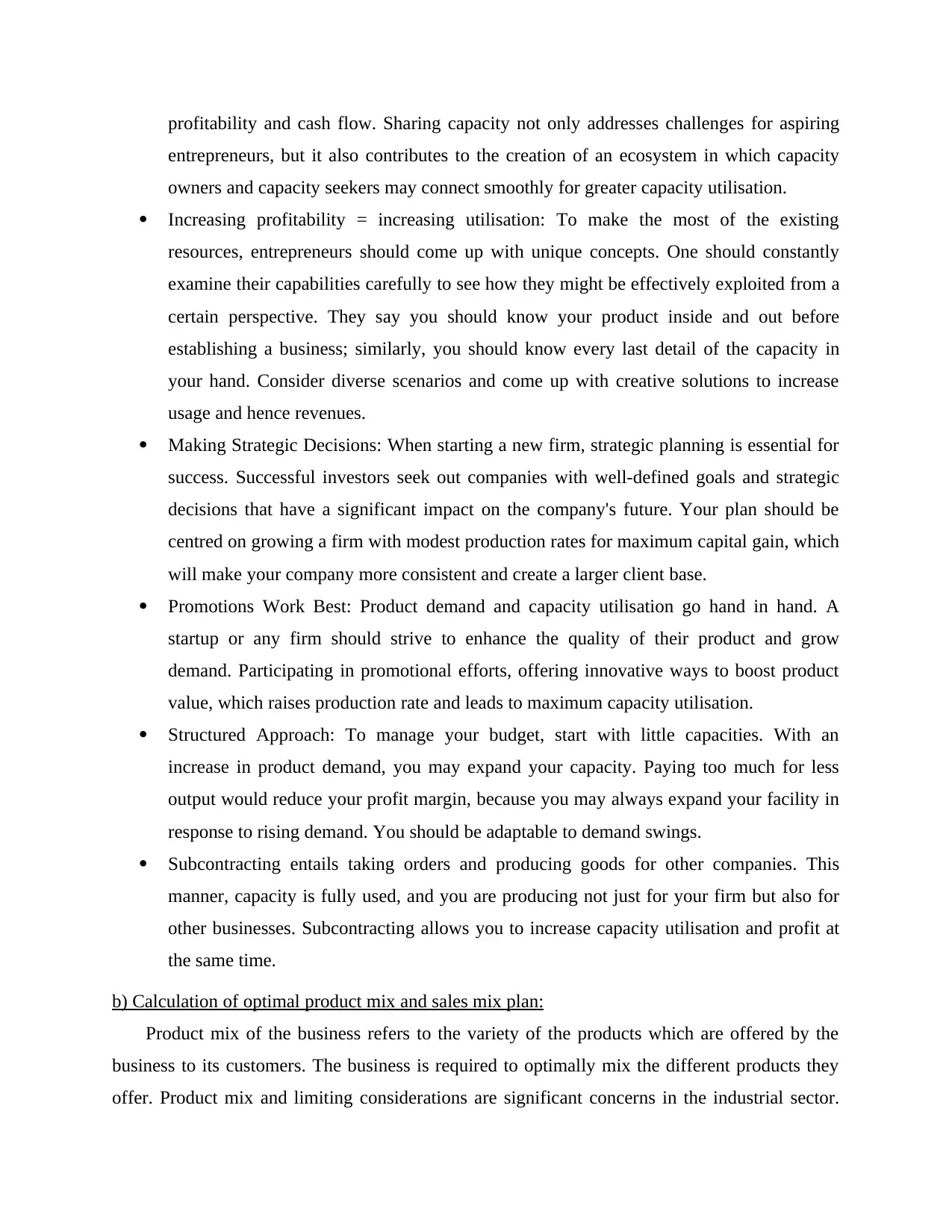
profitability and cash flow. Sharing capacity not only addresses challenges for aspiring
entrepreneurs, but it also contributes to the creation of an ecosystem in which capacity
owners and capacity seekers may connect smoothly for greater capacity utilisation.
Increasing profitability = increasing utilisation: To make the most of the existing
resources, entrepreneurs should come up with unique concepts. One should constantly
examine their capabilities carefully to see how they might be effectively exploited from a
certain perspective. They say you should know your product inside and out before
establishing a business; similarly, you should know every last detail of the capacity in
your hand. Consider diverse scenarios and come up with creative solutions to increase
usage and hence revenues.
Making Strategic Decisions: When starting a new firm, strategic planning is essential for
success. Successful investors seek out companies with well-defined goals and strategic
decisions that have a significant impact on the company's future. Your plan should be
centred on growing a firm with modest production rates for maximum capital gain, which
will make your company more consistent and create a larger client base.
Promotions Work Best: Product demand and capacity utilisation go hand in hand. A
startup or any firm should strive to enhance the quality of their product and grow
demand. Participating in promotional efforts, offering innovative ways to boost product
value, which raises production rate and leads to maximum capacity utilisation.
Structured Approach: To manage your budget, start with little capacities. With an
increase in product demand, you may expand your capacity. Paying too much for less
output would reduce your profit margin, because you may always expand your facility in
response to rising demand. You should be adaptable to demand swings.
Subcontracting entails taking orders and producing goods for other companies. This
manner, capacity is fully used, and you are producing not just for your firm but also for
other businesses. Subcontracting allows you to increase capacity utilisation and profit at
the same time.
b) Calculation of optimal product mix and sales mix plan:
Product mix of the business refers to the variety of the products which are offered by the
business to its customers. The business is required to optimally mix the different products they
offer. Product mix and limiting considerations are significant concerns in the industrial sector.
entrepreneurs, but it also contributes to the creation of an ecosystem in which capacity
owners and capacity seekers may connect smoothly for greater capacity utilisation.
Increasing profitability = increasing utilisation: To make the most of the existing
resources, entrepreneurs should come up with unique concepts. One should constantly
examine their capabilities carefully to see how they might be effectively exploited from a
certain perspective. They say you should know your product inside and out before
establishing a business; similarly, you should know every last detail of the capacity in
your hand. Consider diverse scenarios and come up with creative solutions to increase
usage and hence revenues.
Making Strategic Decisions: When starting a new firm, strategic planning is essential for
success. Successful investors seek out companies with well-defined goals and strategic
decisions that have a significant impact on the company's future. Your plan should be
centred on growing a firm with modest production rates for maximum capital gain, which
will make your company more consistent and create a larger client base.
Promotions Work Best: Product demand and capacity utilisation go hand in hand. A
startup or any firm should strive to enhance the quality of their product and grow
demand. Participating in promotional efforts, offering innovative ways to boost product
value, which raises production rate and leads to maximum capacity utilisation.
Structured Approach: To manage your budget, start with little capacities. With an
increase in product demand, you may expand your capacity. Paying too much for less
output would reduce your profit margin, because you may always expand your facility in
response to rising demand. You should be adaptable to demand swings.
Subcontracting entails taking orders and producing goods for other companies. This
manner, capacity is fully used, and you are producing not just for your firm but also for
other businesses. Subcontracting allows you to increase capacity utilisation and profit at
the same time.
b) Calculation of optimal product mix and sales mix plan:
Product mix of the business refers to the variety of the products which are offered by the
business to its customers. The business is required to optimally mix the different products they
offer. Product mix and limiting considerations are significant concerns in the industrial sector.
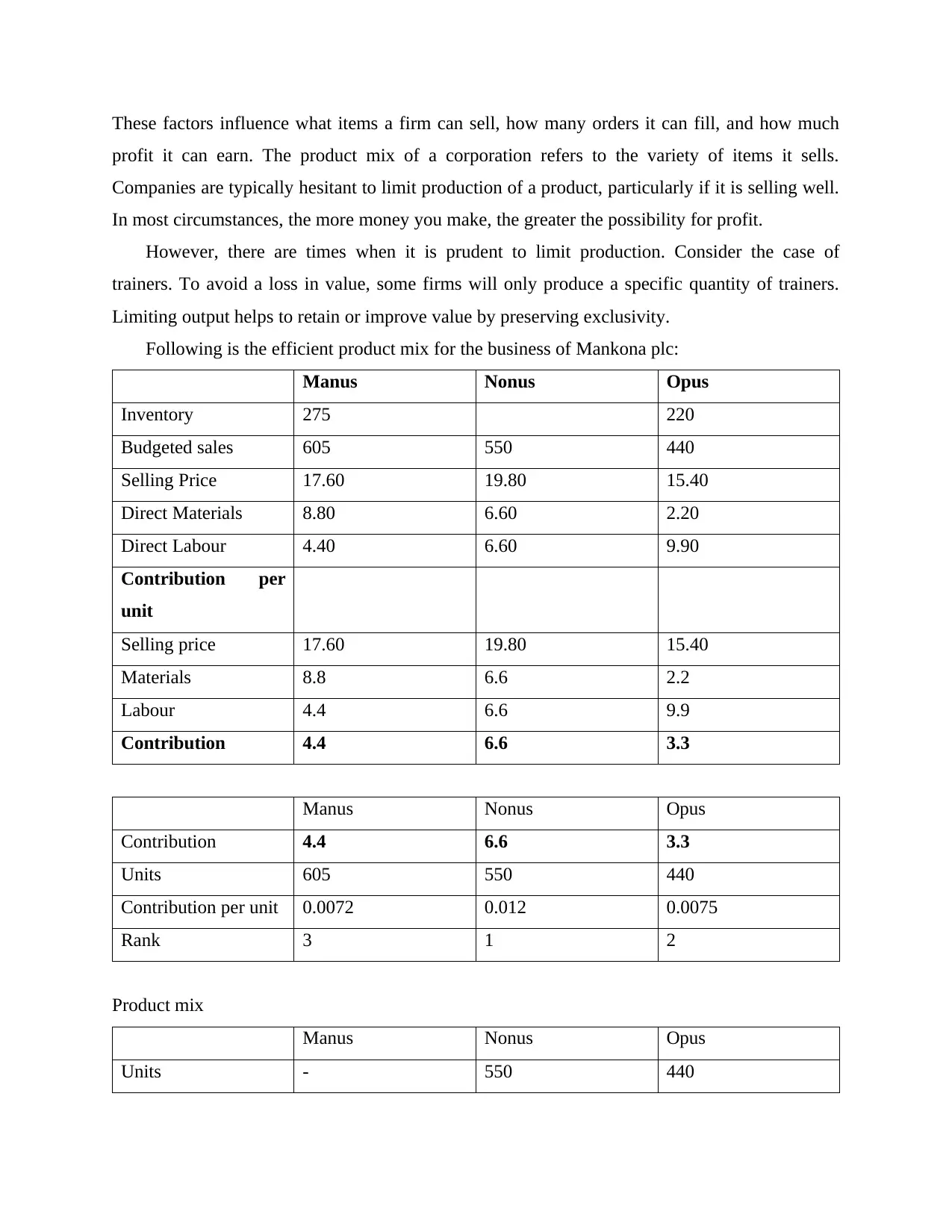
These factors influence what items a firm can sell, how many orders it can fill, and how much
profit it can earn. The product mix of a corporation refers to the variety of items it sells.
Companies are typically hesitant to limit production of a product, particularly if it is selling well.
In most circumstances, the more money you make, the greater the possibility for profit.
However, there are times when it is prudent to limit production. Consider the case of
trainers. To avoid a loss in value, some firms will only produce a specific quantity of trainers.
Limiting output helps to retain or improve value by preserving exclusivity.
Following is the efficient product mix for the business of Mankona plc:
Manus Nonus Opus
Inventory 275 220
Budgeted sales 605 550 440
Selling Price 17.60 19.80 15.40
Direct Materials 8.80 6.60 2.20
Direct Labour 4.40 6.60 9.90
Contribution per
unit
Selling price 17.60 19.80 15.40
Materials 8.8 6.6 2.2
Labour 4.4 6.6 9.9
Contribution 4.4 6.6 3.3
Manus Nonus Opus
Contribution 4.4 6.6 3.3
Units 605 550 440
Contribution per unit 0.0072 0.012 0.0075
Rank 3 1 2
Product mix
Manus Nonus Opus
Units - 550 440
profit it can earn. The product mix of a corporation refers to the variety of items it sells.
Companies are typically hesitant to limit production of a product, particularly if it is selling well.
In most circumstances, the more money you make, the greater the possibility for profit.
However, there are times when it is prudent to limit production. Consider the case of
trainers. To avoid a loss in value, some firms will only produce a specific quantity of trainers.
Limiting output helps to retain or improve value by preserving exclusivity.
Following is the efficient product mix for the business of Mankona plc:
Manus Nonus Opus
Inventory 275 220
Budgeted sales 605 550 440
Selling Price 17.60 19.80 15.40
Direct Materials 8.80 6.60 2.20
Direct Labour 4.40 6.60 9.90
Contribution per
unit
Selling price 17.60 19.80 15.40
Materials 8.8 6.6 2.2
Labour 4.4 6.6 9.9
Contribution 4.4 6.6 3.3
Manus Nonus Opus
Contribution 4.4 6.6 3.3
Units 605 550 440
Contribution per unit 0.0072 0.012 0.0075
Rank 3 1 2
Product mix
Manus Nonus Opus
Units - 550 440
⊘ This is a preview!⊘
Do you want full access?
Subscribe today to unlock all pages.

Trusted by 1+ million students worldwide
1 out of 13